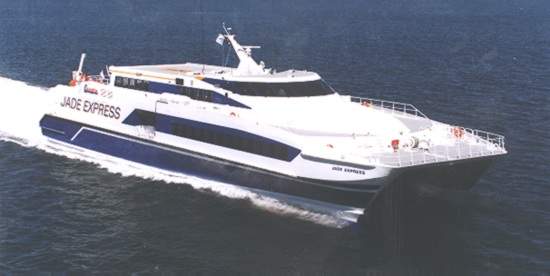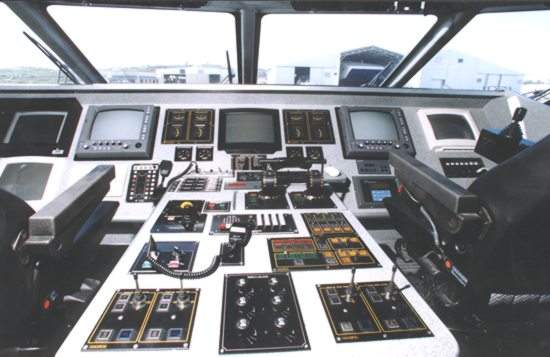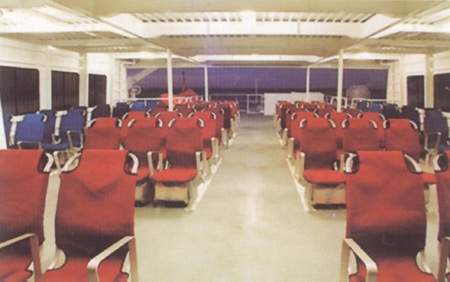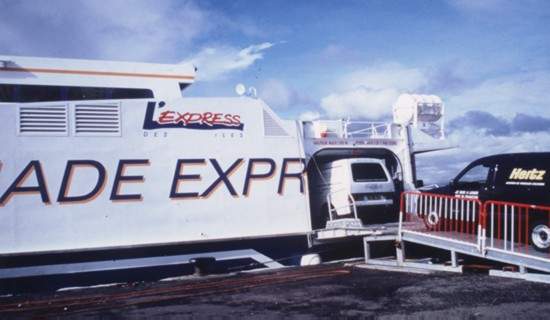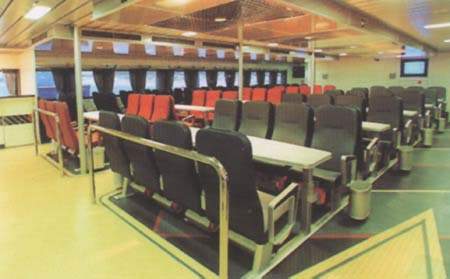Jade Express is the smallest of the Auto Express catamaran class built by Australia’s Austal Ships. Her design shows the versatility of the range because at 48m in length she has a tiny capacity for only ten cars. As such, she is likely to remain Austal’s baby as demand for this type of high-speed vessel is quite limited. Jade Express entered service in April 1998 in the Caribbean operated L’Express des Iles, the ferry subsidiary of Compagnie Chambon. She flies the flag of the France’s Guadeloupe island and, accordingly, was built to meet the classification requirements of the French organisation, Bureau Veritas.
The vessel is scheduled to cover the 110nm route between Pointe a Pitre and Fort de France on the islands of Guadeloupe and Martinique. The scheduled journey time is three and a quarter hours, or three hours 45 minutes if a call is made en route at Roseau on the island of Dominica.
Pleased with the performance and service of Jade Express, Compagnie Chambon confirmed a second catamaran order with Austal in April 1998. In comparison this vessel is much larger with a 40m-long hull and twin decks. She was ordered to be fitted out for 302 passengers; 252 in the main deck saloon and 50 on a semi-enclosed upper deck. This vessel is expected to have a full-load service speed of 35 knots.
FACILITIES
Vehicles enter and leave Jade Express via a hydraulically operated 3m-wide ramp located aft on the port side. This system is designed to allow the vessel to berth at the islands’ existing facilities, with only simple shore ramps required to reach the height of the car deck. The operators of the vessel plan a 30-minute turnaround time in port. Minimum headroom on the deck is 2.1m and structural fire protection and water drenchers are fitted throughout.
Passenger accommodation comprises a mixture of forward-facing rows of triple seats, plus other seats grouped around tables in the main saloon, rows of double and triple seats in the upper saloon and acrylic/canvas seats in a covered sundeck area aft. An emphasis on low-maintenance materials, including the use of vinyl seating upholstery and floor materials, was specified to facilitate ease of cleaning.
Facilities include a bar and kiosk, information desk, four toilets aft in the main saloon and overhead baggage racks along the aisles of the main saloon and across the forward bulkhead of the upper saloon. There is also an 18m³ capacity for baggage and cargo space forward on the car deck.
The area forward in the main saloon has been equipped for the crew of nine with cooking facilities, shower, toilet and lounge.
PROPULSION
Four MTU 16V 396 TE74L diesels, delivering 1,980kW at 1,940rpm, each power a KaMeWa 63 SII waterjet via a Reintjes VLJ 930 gearbox and, for the first time on one of Austal’s medium size catamarans, Geislinger composite carbon shafting.
During trials with an Ocean Leveller ride control system featuring T-foils forward and interceptors on the transoms fitted, the vessel achieved a maximum speed of 40 knots at a deadweight of 49t and a service speed of 38 knots at 90% maximum continuous rating.
Although the vessel will be operated with a bridge crew of two – the captain and engineer – the wheelhouse has been fitted with four chairs. Equipment includes an MTU MCS 5 monitoring system, Ocean Leveller control station and NavMaster electronic chart display.
Safety equipment on-board included three evacuation stations, located midships port and starboard on the main deck and aft on the upper deck, equipped with Viking 5m slides.

